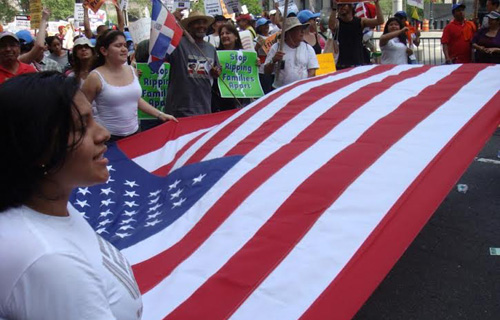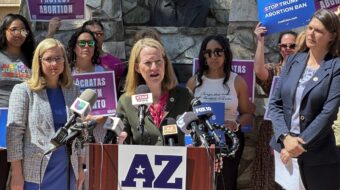
Donald Trump nailed his colors to the mast early on in the 2016 Republican primary. His coming was hailed as a joke by many observers of politics, and the media fueled his outrageous antics like spectators baiting a bear, laughing as it stumbled and bellowed. In the very first GOP primary debate, on August 6th, conservative Fox News journalist Megyn Kelly asked Trump a question about his past characterizations of women, citing instances where he had called them pigs, dogs, or disgusting animals. His response during the debate was defensive, though he attempted to maintain his cool in the spin-room immediately after.
It was when he took to the media and to his infamous Twitter account that the misogynistic abuse flowed in retribution. In an interview with Don Lemon of CNN, Trump observed nastily that Kelly had “blood flowing out of her…whatever” in her supposed anger (although the journalist seemed composed in the interchange during the debate.) On Twitter, he rained abuse down on Kelly’s professionalism for months, obsessed with the subject well into spring of this year. His theme was that she was crazy, off-balance, sick, and shouldn’t have her job.
Along the way, he implied that his fellow GOP candidate Carly Fiorina was an ugly-faced and angry woman and attacked her repeatedly in statements to the press and on social media. As the year wore on and his rivals in the GOP were rapidly eliminated, he trained more of his venom on Democratic candidate Hillary Clinton, attacking her personal life. He accused her of playing the “woman card” and of being shrill and shouting. All of these instances are well-known as gendered attacks, making sure women know that their presence is considered an offense in traditionally male centers of power, and that only women who conform in looks and in tone are considered unthreatening to male ruling power, and therefore acceptable.
The Clinton camp turned adroitly to parry these attacks, issuing an actual plastic “woman card” to supporters, and also airing a TV ad that merely had women repeating exact quotes of Trump’s sexist comments.
On the question of women’s rights, Trump said that there should be some form of punishment for women who get an abortion. As President, he proclaimed, he would shut down the U.S. Government in order to stop federal funding for Planned Parenthood. He’s attempted to walk back that answer, but he has also indicated his willingness to appoint Supreme Court Justices just like the recently deceased Antonin Scalia, which would basically produce the same results.
Signaling this intention to make right-wing judicial appointments was apparently deemed attractive enough to begin luring establishment conservatives into supporting Trump for President, despite their previous objections. They rather quickly began to fall in line and endorse the candidate.
The problem is a lot bigger than just Trump
Meanwhile, in the backdrop of this electoral performance, systemic attacks were being waged against women’s rights, the organizations that they rely on, and on women themselves. While Trump’s antics were capturing the media spotlight, other GOP candidates latched onto the right-wing attacks on Planned Parenthood via fraudulent videos that were produced which purported to show that Planned Parenthood was trafficking in abortion-harvested fetal organs. Carly Fiorina made inflammatory remarks in the September GOP debates, although later it was revealed that she hadn’t even watched the videos in question.
The inflamed rhetoric that these attacks produced led directly to a terrorist attack on a Colorado Planned Parenthood, in which three people died and several were injured during a five-hour gun battle. The suspect was heard to mumble “no more baby parts” when he was apprehended.
Lest we think the attacks on Planned Parenthood and women’s rights died down after the videos were debunked in the media, on June 8th of this year it was reported that the GOP had, in the course of an ongoing House panel investigation into alleged wrong-doing by abortion rights organizations, leaked the personal information of biomedical researchers and Planned Parenthood staffers. House Democrats have called for an end to this panel, calling it a “unique form of congressional harassment.”
The crisis in access to women’s health has been acute. Reports show that hundreds of thousands of women in states with draconian abortion laws are considering or going through with self-induced abortions or are going without heath check-ups. Reuters recently reported that in 1982, there were nearly 3,000 abortion providers. As of 2011, only 1,720 remained. NARAL reports that only 13% of counties in the entire United States have an abortion provider.
This primary election was tragically bracketed by terror fueled by toxic masculinity. In June of 2015, there was the Charleston massacre by Dylann Roof, who claimed his killings in the church of innocent African-American churchgoers stemmed from his racist and paranoid beliefs that Black people raped white women. Nearly a year later, a homophobic wife-beater, Omar Mateen, committed horrific mass murder in a gay bar in Orlando, killing 49 and wounding 53, the majority of the victims being Latino/a.
These outbreaks of mass violence are often begun at home, with violence against women. 40 percent of mass shootings carried out between 2009 and 2012 started first with a shooter targeting his girlfriend, wife, or ex-wife. Three women are killed every day by their partners. Research by the advocacy group Everytown for Gun Safety has shown that when a gun is present in a domestic violence situation, it increases the risk of homicide for women by 500 percent.
The economics of sexism (and racism)
Economic fears and abuse often keep women in violent relationships. Despite an improving economy since 2008, the economic state of American women is still dire. 18 million women in the United States live in poverty. Two-thirds of all low-wage workers are women, and in two-thirds of all families, the primary breadwinner is a woman.
The United States has more elderly women living in poverty than any other industrialized country, a result of historically low-paying jobs that lead to small Social Security incomes. 13 percent of women over 75 are poor, while only 6 percent of men in that category are. Black women face a 16 percent higher likelihood of living in elder poverty than white men.
“Time poverty“, a result of women assuming more work in the home and childcare, results in thousands of hours of uncompensated labor that adds up over a lifetime. Gender parity in wages is still a problem: white women make $0.79 on the dollar made by a white man. The gap for women of color is even wider, with Latina women making only $0.54 and Black women making just $0.64 for every dollar made by a white male.
By 2044, the majority of the United States’ female workforce will be women of color. Today, women of color, especially Black women, account for the highest level of college degrees awarded in the United States. Despite this, young African-American women still experience the highest rate of severe punishments for school infractions. Department of Education data for the 2011-2012 school year demonstrated the disparity. Black males faced suspension more than three times as often as their white counterparts, but Black girls were suspended six times as often.
The over-policing of schools leads to more young women of color being exposed to the juvenile justice system, and having violent encounters with law enforcement. In many states, police are empowered to arrest children for being disruptive in class, with “disruptive” being a rather loose and open-ended category of behavior that includes even minor distractions. In October 2015, an African-American South Carolina teen was brutalized by a male police officer in her classroom, suffering many injuries. #BlackLivesMatter and the #SayHerName campaigns have highlighted the negative and sometimes lethal effect that law enforcement has on adult Black women.
Trans women also threatened
Sexist attacks and oppression extend also to trans women. The rush by GOP-led states to enact bathroom segregation bills against transgender people has a direct link to the 2016 elections. Transmisogyny as a result of these bigoted bias measures has resulted in attacks on transgender women as well as cis women who are not gender-conforming.
Hate preacher James Dobson reportedly attacked transgender women in early June by telling a congregation’s men to shoot transgender women in the head if they are found in bathrooms, as a show of masculine strength. Studies have shown that the women actually in the most danger in public restrooms are transgender women. Biased hate laws elevate violence against transgender women, which has fallen especially heavily on transgender women of color.
Although Donald Trump has come out with lukewarm verbal statements of support for LGBTQ issues, his courting of the evangelical right wing for support, and also his intention to appoint right-wing Supreme Court Justices makes any verbal support moot. His material actions would lead to a stripping of rights for LGBTQ people. Numerous reports have sounded the warning that he is not a moderate on LGBTQ rights, and that supporting him on this basis is dangerous. His stance on deportation alone would create elevated dangers for transgender women, who already suffer terribly in ICE detention centers.
An ongoing rape crisis
The rape crisis has touched nearly every community where women are. Campus rape has been a topic of media attention during this election year, with the recent case of the Stanford rapist Brock Turner, managed to convince the judge that his violation of his victim, so brutal that gravel and pine needles were found inside her genitalia, was consensual. Even though the jury convicted him on all three felony counts, the judge handed down a sentence of 6 months in county jail, later commuted to 3 months. Reports from campus surveys suggest that between 20-27 percent of campus rapes are committed on cis & transgender women and gender-fluid people.
Native American women on reservations are the most at-risk population of women for rape, with 86 percent of rapes being committed by non-Native men. 1 in 3 Native American women are likely to be raped in her lifetime, and they are two and half times more likely to be raped than women of other races. Because of federal laws that prevent tribal courts from having jurisdiction over non-Native offenders, rapists know that they can offend in tribal communities with impunity and face no consequences, as federal U.S. courts often decline to take these cases as well.
These are just a few of the acute crises that prevent women from fully participating in public life in the US. There are several other issues, like media representation, internet harassment (which can silence by gender and race), gender inequity in children’s toys, as well as “symbolic annihilation” and sexist advertising that reinforce stereotypes and keep women from imagining what they can be and should be able to achieve in a modern democracy.
Women will make the difference in 2016
Today, women make up over half of the electorate. Women, especially Black women voters, are a key demographic in putting victories against the ultra-right over the top. Black women voted at a higher rate than any other group – whether by gender, race, or ethnicity – in the 2012 election. Along with other women of color, they played a key role in Obama’s re-election.
The key to defeating Trump and his coalition, a toxic stew of white male anxieties based on racism and xenophobia, will be to mobilize the largest and most diverse coalition possible. Only the total repudiation of the ultra-right and their “suicide squad” of reactionaries will keep the Supreme Court out of the hands of three more potential Scalias. Furthermore, if we can encourage the division found presently in the GOP, we could potentially flip Congress to put us on the road to a progressive agenda, as the unpopularity of Trump, especially with white women and Latinos, puts many down-ticket races in play.
President Obama quoted Marian Wright Edelman at the very first national State of Women summit recently, saying, “It’s hard to be what you can’t see.” Representation in diversity and gender needs to be encouraged at every level, from those who teach our children, to our workplaces, to our unions, to our Congress, and yes, to our Presidency.
This article is based on a report delivered by the author to a meeting of the National Board of the Communist Party on June 15, 2016.

MOST POPULAR TODAY


Zionist organizations leading campaign to stop ceasefire resolutions in D.C. area

Communist Karol Cariola elected president of Chile’s legislature

Afghanistan’s socialist years: The promising future killed off by U.S. imperialism

High Court essentially bans demonstrations, freedom of assembly in Deep South






Comments